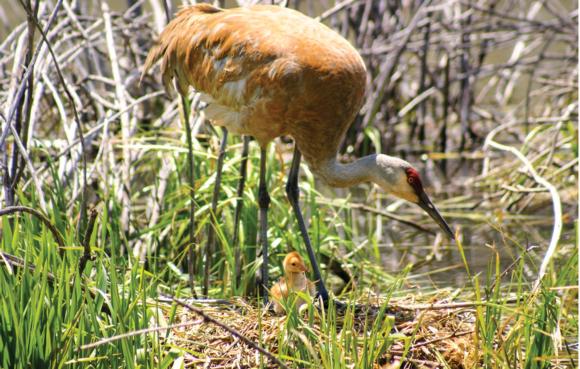Wildlife
This is an excerpt from Where the Road Ends by Meghan M Hicks,Bryon Powell.
Glimpsing a wild animal behaving naturally in a wild place - now that's a fantastic fringe benefit of trail running! Wild animals big and small deserve our utmost respect. Each of them is entitled to space to roam and be free. The backcountry is their home, so this section is designed to help you understand how wildlife behaves and how to be a deferential visitor where these wild things are.

Trail running offers special experiences in nature, like this glimpse of a sandhill crane mother and colt.
The best thing you can do for a wild animal is to give it a wide berth as you pass. As you will see, most wildlife often goes to great lengths to get what they think is a safe distance from you. Give them space so that they don't have to expend extra energy flying off, running away, or becoming stressed by your presence. A good rule of thumb is to give a wild animal enough room so that it doesn't modify its behavior because of you.
Wild animals are not to be feared, but respected. With a little knowledge, you'll understand why certain animals behave the way they do and how to act in their territory.
Follow these general tips on trail running among wildlife:
- Don't feed wild animals, intentionally or unintentionally. For a number of reasons, accessing human food is unhealthy for wildlife.
- Use great care when you spot young wildlife, because mothers will act defensively if they think your presence is threatening their young. Don't come between a mother and its young.
- Herd animals are called that for a reason. They feel comfortable living in groups. Avoid accidentally separating members from a group of wildlife because this may cause them behave erratically.
- Give ungulates like deer, antelope, and elk extra space during the time of year when females are in season, because male members of the species may act in defense of females they think are being threatened. This season happens during autumn in North America.
- If you're trail running with your dog, maintain control of it at all times. Don't allow it to harass wildlife. We'll address dog issues while trail running in greater depth later in this chapter.
- If you travel abroad and trail run in another country, get local advice on what wildlife you may encounter and how you should behave around it.
- Enjoy, enjoy, enjoy! Relish in the opportunity of seeing a wild animal.
SHOP

Get the latest insights with regular newsletters, plus periodic product information and special insider offers.
JOIN NOW


